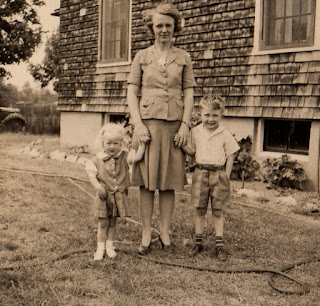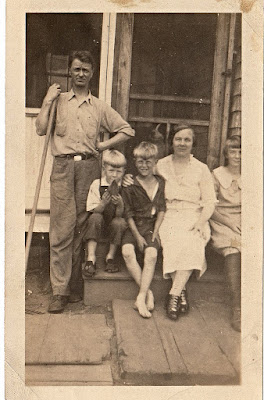 |
| From the Family Collection of Hannah (Champlin) Broadfoot and William Broadfoot Privately held by Midge Frazel, 2016 link to large size of the announcement |
Close to Home: Celebration of Marriage
Around the time (in 1939), that Ada and George were wed, New England life was changing. People married people outside of their neighborhoods, social circles and religion. More mobility and owning a car made more of a difference than we can imagine.
So many of us today come from families where adults have different upbringings that we have a hard time understanding why things were difficult in the past. Ada was a Protestant and George was a Roman Catholic and in those days it made a difference to how they brought up their children. Both of my cousins married people who were Catholic so it worked out in the end.
Ada married George in the church rectory of his church in his neighborhood. Weddings, especially in war time, and in the depression were not lavish affairs. People put on new clothes gathered two people to witness the ceremony and got married.
I didn't know until I read this announcement, that Ada had her sister and George had his brother, Leo, "stand up for them". It states they were married in the Parish Center but it was likely in the living room of the rectory. I have it in Ada's own handwriting in my interview notes so it would be clear that they were NOT married in the church itself.
The 1939 Westerly City Directory lists Ada with my father as "Harcom" and my grandfather "Thos" as dying on 21 April 1937. Uncle Bill was not listed but he would have only 17 years old. Today, you have to be over 17 to be listed in the (public) Street Directory if there is one published in your area.
In the 1940 census, Ada and George were both working at the Bradford Dye and my father and his brother live in the same house with them. Bradford Dye had a government contract for cloth dyed in "government colors" for many, many years and it kept people working and living in the mill housing. My aunt is a laboratory assistant. We know that she is pregnant with her first child in 1940 and my generation of this family began there.
So many of us today come from families where adults have different upbringings that we have a hard time understanding why things were difficult in the past. Ada was a Protestant and George was a Roman Catholic and in those days it made a difference to how they brought up their children. Both of my cousins married people who were Catholic so it worked out in the end.
Ada married George in the church rectory of his church in his neighborhood. Weddings, especially in war time, and in the depression were not lavish affairs. People put on new clothes gathered two people to witness the ceremony and got married.
I didn't know until I read this announcement, that Ada had her sister and George had his brother, Leo, "stand up for them". It states they were married in the Parish Center but it was likely in the living room of the rectory. I have it in Ada's own handwriting in my interview notes so it would be clear that they were NOT married in the church itself.
The 1939 Westerly City Directory lists Ada with my father as "Harcom" and my grandfather "Thos" as dying on 21 April 1937. Uncle Bill was not listed but he would have only 17 years old. Today, you have to be over 17 to be listed in the (public) Street Directory if there is one published in your area.
In the 1940 census, Ada and George were both working at the Bradford Dye and my father and his brother live in the same house with them. Bradford Dye had a government contract for cloth dyed in "government colors" for many, many years and it kept people working and living in the mill housing. My aunt is a laboratory assistant. We know that she is pregnant with her first child in 1940 and my generation of this family began there.







